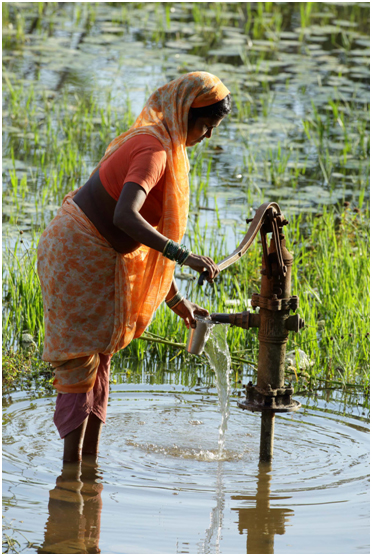

Water Galore
Climate change for the people of Gorakhpur City in eastern Uttar Pradesh, India is not a distant notion. Unseasonal rain, hailstorms and erratic weather have already made it a frightful reality for this city. Rapid urbanization and decreasing capacity of the city to provide basic infrastructure services and other civic amenities are further exacerbated by climate change impacts. The livelihoods of poor inner city as well as the rural migrants living in the fragile peri-urban areas are most severely impacted. Already, the peri-urban areas of Gorakhpur are prone to recurring floods and water-logging for 2 to 3 months every year.

Degrading Lungs of the City
The peri-urban ecosystems which act as flood buffers, provide food security to the city dwellers and regulate the micro-climate are degrading day by day due to expansion of city and ensuing land-use changes. Gorakhpur’s peri-urban land is a much coveted space, with the developers, real estate builders and municipal bodies eyeing it as a prime location for the city’s waste, refuse and cheap housing. Standing crops have given way to urban sprawls; farmers turn into labourers and open water bodies morph overnight into shiny new multi-storied buildings. This straining of natural resources, absorption of existing agricultural lands, open green spaces and water bodies on the city’s periphery is disrupting its ability to be resilient to climate change impacts.

The Vulnerable Peri-Urban Farmers
For farmers, life turns more chaotic. Agriculture has always been vulnerable to the vagaries of nature, but here the changing climate spells doom for the small and marginal farmers in peri-urban areas. Peri-urban agriculture becomes more expensive as the input costs of seeds and fertilizers are increasing and the net gains are decreasing. In flooded fields and waterlogged land, unsure of whether their crops will yield enough and unable to meet their past debts, many farmers migrate to urban areas in search of other livelihood opportunities. This distressed migration leads to infrastructural development on their agricultural lands, destroying the natural ecosystems there. The consequence of this conversion is the decreased “Food Resilience” of the city as the peri-urban agriculture is a major source of vegetables and fruits for the city dwellers.

Innovations in the peri-urban agriculture
Conservation of peri-urban agriculture and ecosystems by innovative farming techniques and adoption of climate resilient agriculture is central to build resilience to climate change for the entire urban area. Use of flood resilient crop varieties which can sustain in water-logged fields, loft framing, mixed farming and adoption of integrated farming methods help the farmers fight climate change. So, with more food produced in the peri-urban areas, better profits are made in the ready market available in the city itself. This flood resilient agriculture helps these peri-urban farmers become more robust, and simultaneously enhances the livelihood security of the vulnerable groups and ensures food security of the urban poor.

Community-based Approach
City’s expansion in the peri-urban land is also degrading the common property resources like pasture lands, ponds, lakes and open green spaces. The common property resources play an important role in enhancing the city’s resilience to climate change, especially the flood resilience. Besides adapting the innovative farming techniques, the small and marginal farmers from peri-urban villages of Gorakhpur have come forward for the protection of these common property resources by forming small community groups and advocating to stop illegal encroachments.
Cities cannot operate in isolation but within a ‘sphere of dependence’ on surrounding peri-urban areas and their ecosystems. It is of utmost importance to conserve peri-urban agriculture and ecosystems as they give multiple benefits including livelihood security of small and marginal peri-urban farmers as well as ensure food and flood resilience for the urban dwellers contributing to urban climate change resilience on the whole.
A recently formed group ‘Urban, Peri-Urban and Ecosystems Working Group’ looks at how nature can help improve urban resilience and help mitigate the impact of natural or manmade disasters. You are welcome to join this initiative, which hopes to be a learning platform for exchange of ideas and experiences across the various landscapes.
ACCCRN partners, Gorakhpur Environmental Action Group (GEAG), Mercy Corps Indonesia and Ecosystems Services for Poverty Alleviation, look at critical themes here, to be able to undertake joint advocacy initiatives in a collective form.
Click here to register
You may also write to us with any related queries or for further information at info@geagindia.org . We look forward to your feedback.